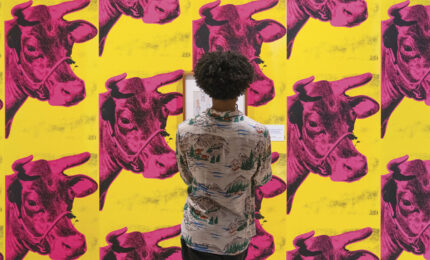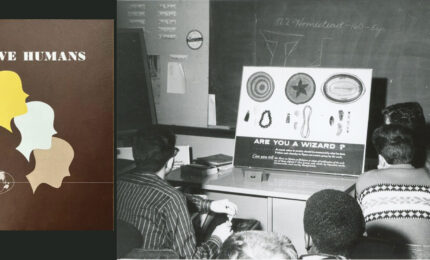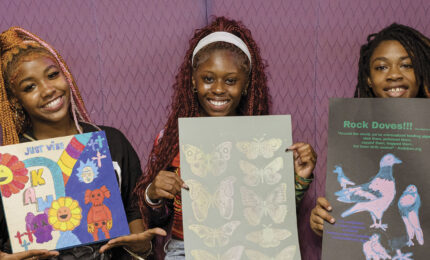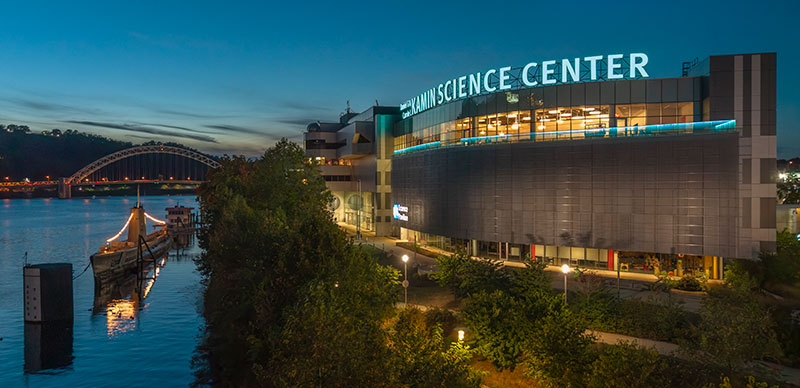A little after noon on a brisk Tuesday in January, Dan Kamin stood before a crowd gathered inside Carnegie Science Center and recalled a science project he’d created as a teenager seven decades earlier.
Wearing a celestial-themed necktie with planets floating amid a starry night sky, Kamin gestured from behind a lectern to a 4-foot-long metal tube at his right, which was angled toward the heavens.
“I vividly recall crafting my own telescope during many inspired visits to The Buhl,” Kamin told the audience. “So, I have a great appreciation for the role the Science Center plays in educating and inspiring our young people.”
Kamin would follow in his grandfather’s footsteps and pursue a career in commercial real estate development. But he never lost his fascination with astronomy and the big existential questions he would ask himself as he peered through the telescope eyepiece after visits to the Buhl Planetarium and Institute of Popular Science, the precursor to the Science Center.
‘A Lifelong Love of Astronomy’: Read about how Dan and Carole Kamin formed a personal connection with Carnegie Science Center.
That’s why he and his wife, Carole, had come to the North Shore that day—to announce a $65 million gift to the Science Center, which will be renamed the Daniel G. and Carole L. Kamin Science Center in their honor. This, the largest-ever monetary gift since Andrew Carnegie founded Carnegie Museums in 1895, will provide transformative financial support as the Science Center pursues its ambitions for inspiring new generations of science enthusiasts and becoming a national leader in its field.
“As a continuation of Dan’s passion for the night sky, this gift enables future generations of visitors to discover their own passions, powered by curiosity, here at the Science Center,” says Jason Brown, Henry Buhl, Jr., Director of the Science Center and vice president of Carnegie Museums.
Part upfront gift to the endowment and part bequest, the Kamins’ gift—when fully realized—will quintuple the Science Center’s endowment, from which it can draw about 5 percent annually to support its operating budget and fund special projects.
Over the coming year and a half, the Science Center is investing in a rebranding, with a new visual identity and logo to reflect the name change, new signage, and a new website. It will expand its already robust staff training. And, longer term, the Kamin gift will advance planning efforts to overhaul the Science Center’s 12-acre campus to be more welcoming to a wider community, especially its North Side neighbors, and provide ongoing support to plan new exhibitions that incorporate the latest, most relevant science.
“Our mission has always been to connect people with science, igniting a curiosity that lasts for a lifetime,” Brown says. “Our expanded vision is to become the most relevant science center in existence, where we focus on the most relevant topics in science.”
Current Science
Last summer, as wildfires devastated Canada and blanketed much of the Northern United States in an eerie orange haze, the Science Center’s leadership team wondered how they could quickly respond to this major event.
The Science Center offered digital programming in which the public could hear a virtual presentation by scientists and ask questions. But the museum’s vision is to do much more.
 Photo: John McColgan
Photo: John McColganSince its inception, the Science Center has aimed to be a trusted source of current scientific information. But science is constantly changing and exhibitions are expensive to produce, requiring years of fundraising and development. The Kamin money—in combination with other gifts—will provide the financial flexibility for the Science Center to begin planning new exhibitions much more quickly and regularly, says Marcus Harshaw, the Science Center’s associate museum director of museum experiences.
In creating new exhibitions that respond to current events, Harshaw wants to tap into the local expertise of Pittsburgh’s scientific community. To do that, the Science Center is creating a science communications advisory council of academics and researchers from local universities, a group that can be “kind of on speed dial” to offer input the next time there’s an issue of scientific importance in the news.
“So the next time there is a Canadian wildfire, we have people we can just reach out to so we can immediately build a program, build discussion, build exhibitions around,” Harshaw explains.
“Our mission has always been to connect people with science, igniting a curiosity that lasts for a lifetime. Our expanded vision is to become the most relevant science center in existence, where we focus on the most relevant topics in science.”
Jason Brown, Henry Buhl, Jr., Director of the Science Center
This ability to discuss relevant topics using the latest science is a critical aspect of the Science Center’s vision, and involves more than just exhibitions, says Kim Amey, the Science Center’s chief of staff. It includes responding to scientifically significant events through social media or news interviews, hosting panel discussions at the Science Center, and putting on other public programming like camps, classes, and theater shows.
“What this Kamin gift allows us to do is invest in new exhibition concepts and program ideas, to accelerate the pace of fundraising and planning, and to be more responsive to community needs in a changing world,” Amey says.
Investing in new exhibitions, of course, is at the core of the Science Center’s mission and Dan Kamin’s desire for its future.
“As someone who vividly recalls many inspiring visits to the Buhl Planetarium as a child, I look forward to a continuation of experiences that foster interactive and hands-on learning experiences for both kids and adults,” Kamin says. “The Science Center is an incredible place to dream, explore, and contribute to the world of science.”
In the meantime, the Science Center is embarking on major updates to its Highmark SportsWorks® gallery and also the third floor, where its BodyWorks exhibition will be replaced by the relocated BNY Mellon Fab Lab anchoring a new maker learning hub. Those changes, which are being supported by other funders, are expected to be completed in 2025.
Investing in Staff
Exhibitions that explore the vanguard of science require investments in staff as well. That means expanding professional development opportunities.
Amanda Murphy is an early childhood educator at the Science Center who has taken advantage of any and all training opportunities, from fire safety to attending professional conferences. She’s even taken a theater improv class, offered internally through the Science Center’s “CSC University.”
Why improv?
“Kids say the darndest things, so you have to respond to whatever they say to you, and sometimes it’s in front of the whole class,” Murphy explains. “You have to be quick on your feet.”
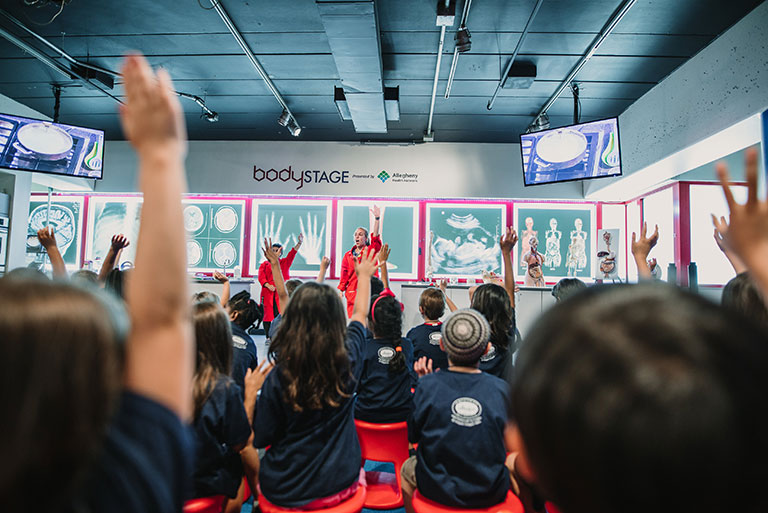 Photo: Nic Lockerman
Photo: Nic LockermanThe CSC University trainings are designed and taught internally by existing staff who have expertise in an area, whether it’s exhibit fabrication or working with Microsoft Excel. The Kamin gift will fund expanded training opportunities, both inside and outside the museum, which will be essential for staff members to keep up with newer exhibitions that respond to current events.
“The professional development opportunities that are good for a program presenter who’s in the education department are very different than those for an exhibit designer who is fabricating and developing new programming and exhibit ideas,” says Steve Kovac, associate museum director, service and engagement. “Part of our training model is to have staff find those opportunities themselves. We think if they identify the opportunities, they’re going to be much more invested in it. And this gift allows us to do just that.”
For Murphy, attending conferences has been a valuable way to make connections and grow in her position. She’s met educators at other museums, such as the Field Museum in Chicago, to compare notes and learn about different approaches. But the grant funding that has supported her participation in these conferences is ending this year. Having a portion of the Kamin gift available to her will open up new opportunities after the grant is finished.
“I was excited that [professional development] was one of the priorities. Not everybody in our museum is an educator or has a science background,” she says. “Me being able to go to conferences and get the latest science information is life changing for my own professional growth and for the Science Center’s programs. The opportunities are endless.”
Brad Peroney, director of public and community programming, has been at the Science Center for 21 years and has been a big booster for professional development. He helped start CSC University and has taught many of the classes, from Science Denial in the 21st Century to Backyard Bird Science.
Expanding learning opportunities outside the museum is more than a nice employee benefit, he says. It’s essential to the institution’s mission.
“We’re an educational organization,” Peroney says. “If we’re not also learning while doing this work, then we’re only fulfilling half of our duty as an educational institution.”
The Kamin gift will also help furnish a place for staff to take lunch breaks, something they’ve asked for in the past. These kinds of investments will hopefully return dividends in staff retention, says Kelly Gascoine, director of workforce development.
“We’re an educational organization. If we’re not also learning while doing this work, then we’re only fulfilling half of our duty as an educational institution.”
Brad Peroney, director of public and community programming
“Our hope is that they’ll continue their careers within the Carnegie Museums,” she says, “and the training and professional development that we’ve been pouring into them, they will just pour back into their interactions with visitors, build those visitor experiences, and we can support them throughout their careers.”
Being a Good Neighbor
Another essential aspect of the Science Center’s vision for the future involves being a good neighbor on the North Shore, be they residents of the Manchester neighborhood or staff of nearby employers.
John Thornton, who is CEO of the Manchester-based space research company Astrobotic, can see the Science Center from his office window. But the two places are physically separated by Route 65 and a gauntlet of pedestrian hazards. It would be an unpleasant walk, to say the least, he says, crossing busy multilane roads and beneath a dark overpass to get to the Science Center.
“Route 65 creates a big divide that cuts the Science Center off from the community here in Manchester,” Thornton says. “That’s been a real challenge for the community. If the Science Center is successful in bridging that divide, that’s going to be a really big deal.”
The Science Center is still figuring out how to be that bridge. Part of it will involve offering more public programming beyond its own walls. The Science Center campus stretches across 12 acres, much of it surface parking across the street from its main buildings on Casino Drive. Brown and his team are contemplating how better to use that space to engage with its neighbors, whether it’s through one-time events or something more permanent to serve as “connective tissue” with the rest of the North Shore.
“We want to be a place that draws people in as a destination that is not just the Science Center itself,” Brown says. “That would involve creating opportunities to engage with science outside of our building, so people could come and experience outdoor science, hands-on stuff.”
Engaging with the community also will involve creating a more accessible and inviting riverfront experience, Brown says. A pedestrian and biking trail runs directly behind the museum. And the Cold War-era submarine USS Requin is moored along the banks of the Ohio River, where it hosts tours and special events. Brown wonders whether there are more effective and sustainable ways to use that waterfront space.
“Is there a way we can bring people to the riverfront differently?” Brown muses. “What about a public marina? What about a longer dock where we can interpret the submarine while walking alongside it instead of a single gangway that runs out onto it?”
“The Science Center is an incredible place to dream, explore, and contribute to the world of science.”
Dan Kamin
He notes that the USS Requin is in need of significant repairs. The Science Center has started to craft a vision for Requin’s next chapter that may involve the monumental task of lifting the 1,516-ton craft from the water to repair and restore its deteriorating hull, make cosmetic improvements, and change the way it’s displayed.
“The submarine has been in its current location for over 30 years, and there has been inconsistent maintenance below the waterline on it,” Brown says. “We find ourselves in a position where it really needs a full set of maintenance.”
Once those repairs are made, the Kamins’ gift to the Science Center’s endowment will offer a steady source of funding for ongoing maintenance, so that it never has to fall into such disrepair again.
“We’ll have the money every single year to do whatever maintenance it needs, regardless of what it is, and hopefully not get back to a point where we need to raise millions of dollars to fully restore and conserve it,” Brown says. “That’s really exciting.”
Meanwhile, the Science Center is engaging with Riverlife, a nonprofit organization devoted to redeveloping Pittsburgh’s downtown riverfront, and the U.S. Army Corps of Engineers to create a plan for improving the waterfront for pedestrians, cyclists, and also the wildlife that lives there.
Riverlife and the Army Corps of Engineers are collaborating on a $20 million ecological restoration project to improve a three-quarter-mile stretch of riverfront from Acrisure Stadium to the West End Bridge. The Science Center sits right in the middle of that project and will be key in deciding whatever happens there.
Riverlife CEO Matt Galluzzo says his team has been in biweekly conversations with the Science Center, whose vision for the future of its campus, he says, “aligns perfectly with our organizational values and priorities.”
“The transformation will not only enhance the overall visitor experience but create a lasting positive impact on the link to the Manchester community for generations to come,” Galluzzo says.
These are long-term initiatives that will require additional fundraising. But the Kamin gift means that people can begin work on some aspects immediately. It means that the Science Center’s vision doesn’t have to remain a theoretical possibility—it can start becoming a reality.
“We believe in Jason,” Dan Kamin says. “And we support the work of people who we believe in and who are inspired to bring about positive change.”

